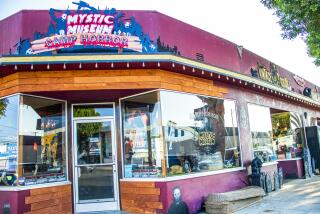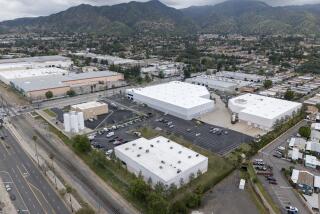No Booty, Booze or Bones : Al Capone’s ‘Vault’ Yields Its Treasure: Dirt, Debris
- Share via
CHICAGO — A giant concrete vault believed built by Prohibition-era gangster Al Capone was opened Monday night, but it was not filled with the booty, booze or bones that searchers had hoped to find. Instead, they found only dirt and debris.
But the search was a true Chicago-style event, reflecting the awe this city continues to have for its most notorious former resident.
Carnival-like hype and hoopla surrounded the vault’s opening during a live two-hour television program. Hundreds celebrated the occasion at an “Al Capone Safecracking” charity ball. A crowd of curious spectators gathered outside the building containing the “vault.” And inside, an array of federal and local law enforcement officials and a small army of reporters gathered.
$800,000 Tax Debt
Internal Revenue Service agents who claim that Capone still owes the government more than $800,000 were there to protect the interests of the federal Treasury. Cook County Medical Examiner Dr. Robert Stein was there in case bones or mummified bodies were found. Chicago police crime lab technicians were there, apparently to gather evidence.
Perhaps never in Chicago’s history has a pile of dirt attracted so much attention.
“Seems like we struck out,” said Geraldo Rivera, who hosted the telecast, playing amateur historian and neophyte urban archeologist.
“Absolutely we’re disappointed,” said John Joslyn, producer of the $1-million telecast.
Located in the basement of the vacant and long-neglected Lexington Hotel--once Capone’s headquarters--the “vault” was really a 125-foot-long, 8-foot-high, 8-foot-wide concrete slab.
Secret Stairways
Speculation that it was constructed by Capone, or for Capone, has been building for months, fueled by the discovery of several secret stairways in the old 10-story hotel and former Roaring ‘20s brothel.
Capone had lived on the fifth floor of the hotel, just south of the Loop business district, during the late 1920s and early ‘30s, a time when Chicago gained its unshakable reputation as the nation’s gangster and corruption capital.
During Monday night’s program, the thick concrete slabs and limestone walls of the vault were cut with special saws, pulled down with a small bulldozer and blasted with dynamite. Each wall yielded only another chamber filled with dirt and occasional debris, such as Prohibition-era bottles.
Earlier excavations in the basement of the Lexington uncovered several secret passageways believed to be routes that Capone and his gang used to evade raiding lawmen.
Empty in 15 Minutes
“Old-timers claim Capone could empty out the hotel in 15 minutes without anybody ever going into the streets,” said Patricia Porter, executive director of the foundation that now owns the building.
The television program was available to 94% of the nation’s viewers through both WGN-TV, a super-station, and syndication to 181 local stations. It will be shown later in at least 14 countries.
The expedition into Capone’s vault was punctuated with film clips of the Capone era and interviews with people who knew Capone and his associates.
To add an air of authenticity to the production, host Rivera demonstrated the use of a Prohibition-era Thompson submachine gun and detonated a dynamite blast using a Capone-era plunger.
“A pot of gold would have been more fun,” said Rivera at the program’s end, “than just chasing rainbows.”
More to Read
Sign up for Essential California
The most important California stories and recommendations in your inbox every morning.
You may occasionally receive promotional content from the Los Angeles Times.










